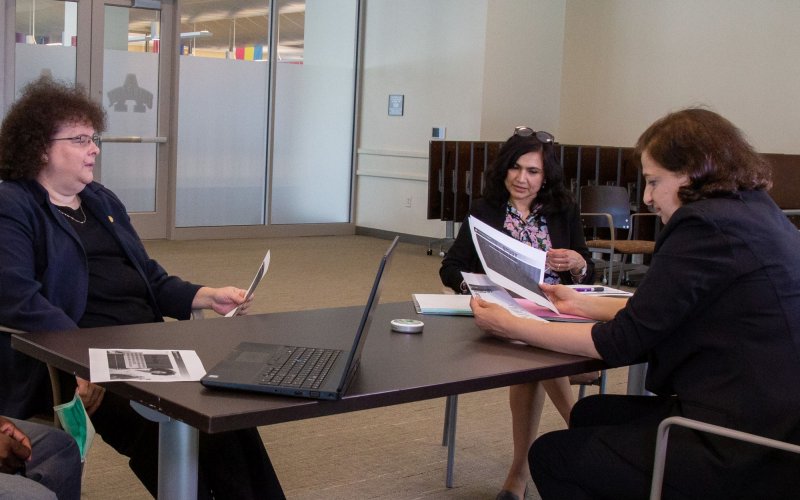Study: Tailor Healthcare Messages to Language and Culture of Target Community

ALBANY, N.Y. (June 27, 2023) — Getting health information from a trusted source during the COVID-19 pandemic translated into higher rates of vaccination among foreign-born U.S. residents who are not native-English speakers, a team of researchers from the College of Arts and Sciences and Rockefeller College of Public Affairs and Policy found.
The study, “Exploring the Role of Information Sources in Vaccine Decision-Making Among Four Culturally and Linguistically Diverse Communities in the U.S.,” was published in April as a chapter in the open access book Democratizing Risk Governance — Bridging Science, Expertise, Deliberation and Public Values (Palgrave MacMillan).
The researchers surveyed members of four culturally and linguistically diverse (CALD) communities whose primary languages were Arabic, Bengali, Chinese and Spanish, to determine whether the decision to get vaccinated differed and whether community members had access to health information from sources they trusted.
While the majority of those surveyed had been or intended to be vaccinated, results among the four communities varied. Spanish speakers reported they could find trustworthy health information, and most were vaccinated. Among Arabic speaking communities, however, only about 25 percent found trusted information and were vaccinated.
The research team included College of Arts and Sciences Dean Jeanette Altarriba, also a professor of psychology; Associate Professor Rukhsana Amed, the principal investigator, from the Department of Communication; and Associate Professor Dina Refki from Rockefeller’s Department of Public Administration and Policy. Research was also conducted by graduate students Sana Abdelkarim, Mary Avery and Erting Sa. Initial funding for the study was provided by the SUNY Prepare Innovation and Internship Program.
“Language is a fundamental part of communication, and the effectiveness of messages related to health and well-being rests with the ability to understand and comprehend the information that is being presented,” Altarriba said. “The current work reveals the critical need to provide health information in languages that can reach as many people as possible and the need to expand and strengthen policies that provide culturally- and linguistically- relevant information for individual communities.”
The chapter notes that members of CALD communities often were at higher risk for COVID-19 infection and death for a variety of reasons: overrepresentation in essential jobs, including health care; overcrowded housing and work situations that made social distancing unfeasible; lack of access to health care; and a “lack of culturally and linguistically appropriate prevention materials.”
“The current study inquires if members of CALD communities can obtain health information that they trust and the sources they rely on to make vaccination decisions,” the chapter reads. “Understanding the contexts of the sources of health information they rely on can inform tailored packaging of vaccine-related information to ensure it appeals to and reaches targeted members of CALD communities so that they can make informed decisions about vaccination.”
The research team concluded that to maximize health outcomes, policy makers and healthcare practitioners should use the existing sources that members of distinct CALD communities already trust, such as native language newspapers and social media sites, as well as trusted community leaders.
“Our work underscores the importance of policies that address social determinants of health which hinder culturally and linguistically diverse populations from accessing life-saving measures,” Refki said. “One size does not fit all when it comes to healthcare messages or interventions. We need to customize and tailor to the unique needs of members of each community and the socioeconomic conditions that can make generic approaches ineffective."
Ahmed said that a key component of the project was training students in academic research and knowledge dissemination. “Research training opportunities were created to enhance student engagement in all aspects of the research process, which also allowed the project leaders to benefit from the interest, energy and capacity the students brought to the project while preparing them for their future professions,” she said.
Having an interdisciplinary research team — from the fields of communication, psychology and public policy — enhanced training and mentoring opportunities, Ahmed said.
“Through hands-on learning and training, the students were able to practice and apply various aspects of mixed-methods research, particularly survey and interview approaches," she said. "In collaboration with the team leaders, students played an active role in disseminating research findings by participating in the SUNY Student Success Summit, producing a policy brief, infographic and book chapter for publication, as well as writing research reports and manuscripts, and delivering conference presentations. As a project team, we are continuing this collaboration for data analysis, writing research summary reports, developing manuscripts for publishing in peer-reviewed journals, and delivering conference presentations.”




